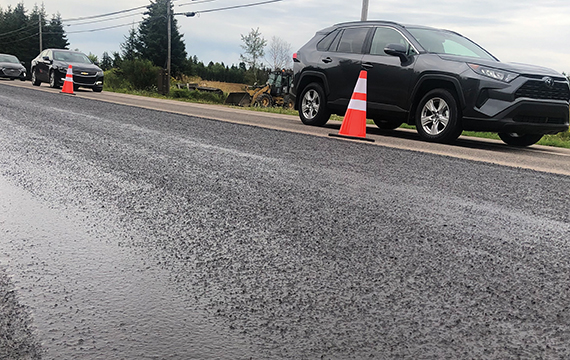
Asphalt pavement plays a significant role in our everyday lives, more so than we sometimes realize. We drive on it, walk on it, play on it, park on it, and more. In an ideal world, an asphalt pavement would remain smooth and in perfect condition, from the moment it was paved, but unfortunately, that is not the case.
Asphalt pavements endure much wear and tear from cars, trucks, climate conditions and just everyday use. So, over time, asphalt surfaces develop distresses such as potholes, cracks, deformations, and various other types of distresses which are unpleasant and unsafe. These distresses can reduce performance and shorten service life of asphalt pavements. That said, continuously addressing these issues as they come up, can keep distresses and overall repairs to a minimum. Therefore, regular, and ongoing maintenance to protect the asphalt surface is crucial and can be achieved through proper pavement preservation.
What is pavement preservation?
Pavement preservation is the implementation of a long-term strategy that enhances pavement performance, life, and safety; it is primarily concerned with minimizing project-level life-cycle cost for an agency. (U.S Department of Transportation, 2016) Pavement preservation employs treatments such as chip seal, slurry seal, microsurfacing, scrub seals, cape seals, fog seal, crack seal, patching, or ultra-thin overlays designed to enhance only functionality (e.g., thin wearing courses for friction and/or noise).
Pavement preservation inherently improves pavement sustainability, because these are typically low-cost, low-environmental-impact treatments that prolong the life of the pavement by delaying major rehabilitation activities. This conserves energy and virgin materials while reducing greenhouse gas (GHG) emissions over the life cycle.
Some examples:
A chip seal treatment consists of applying a layer or multiple layers of asphalt binder (hot or emulsion) with one or more layers of embedded aggregate to the existing pavement surface. Chip seals are used to address issues such as minor cracking, raveling and oxidation, where the PCI is between 60 to 90. When used appropriately, chip seals provide a new skid resistant wearing surface, reduce water intrusion, and can extend the asphalt pavement life up to five to seven years.
A slurry seal consists of a mixture of asphalt emulsion (which may be polymer-modified), mineral aggregate, water, and additives, that is proportioned, mixed, and uniformly spread over a properly prepared asphalt surface at a single stone thickness. A slurry seal is designed to extend the life of asphalt pavements in good condition, with a PCI (pavement condition index) of 77 or greater, to address issues such as loss of friction, raveling, or oxidation. Slurry seals can extend the asphalt pavement life up to five to seven years when used appropriately.
A microsurfacing treatment consists of a carefully designed mixture of polymer-modified asphalt emulsion, mineral aggregate, water and additives. Like a slurry seal, it is proportioned, mixed, and uniformly spread over a properly prepared surface. Microsurfacing is applied as a homogenous mat which adheres firmly to the prepared surface and has a skid-resistant texture throughout its service life. This treatment is used to address issues such as rutting, uneven surface profile, loss of friction, raveling, oxidation, where the PCI is 70 or greater. When used appropriately, microsurfacing can extend the asphalt pavement life up to six to eight years.
Crack sealing involves the placement of an adhesive material into and/or over working cracks (i.e., those that open and close with temperature changes, such as longitudinal and transverse, thermal and reflective cracks at the pavement surface, where the PCI is 70 or greater. It prevents the infiltration of water into the pavement structure and can extend the asphalt pavement life up to three to five years.
An ultra-thin lift asphalt overly consists of an asphalt mixture of paving grade asphalt and fine aggregate that is produced at a hot mix plant. While there are many variations, ultra-thin lift asphalt overlay is typically applied at .75” to 1.0” depth on roads in good condition (PCI 70 or greater) to prevent further deterioration of the pavement. It can be used to address issues such as low-severity cracking, raveling, friction loss, and oxidation. When used appropriately, ultra-thin overlays can extend the pavement life by up to eight to ten years.
An extensive list of pavement preservation treatment options is available on the Pavement Preservation & Recycling Alliance website roadresource.org. It includes the most current guidelines, process information, research, success stories, and in-depth quality assurance recommendations.
What is the right treatment at the right time?
The key to ensuring that pavement preservation improves sustainability lies in choosing the appropriate treatment for the known distress and applying it at the right time because each type of treatment serves a specific purpose in the service life cycle of asphalt pavements. Choosing the right pavement preservation treatment and the right time of application can be effectively managed by referencing an agency’s pavement management system.
The pavement management system is a tool that agencies use to collect pavement distress data such as PCI including information on the type and severity of existing distresses, then analyze, and implement appropriate cost-effective preservation treatments of the pavements. This tool is a deliberate effort on the part of transportation agencies to integrate pavement preservation into pavement management through accurate and consistent data collection and analysis of pavement conditions.
The desired outcome is that the need for pavement preservation treatments and their timing of application can be identified within the pavement management system and that the benefits realized from the application of the treatments can be accounted for in the system’s optimization analysis. (U.S Department of Transportation, 2016)
Wakefield is the Canadian and Research Engineer for the Asphalt Institute. She is based in Ontario.













